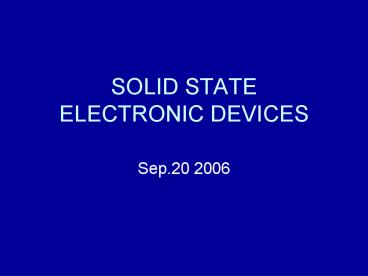SOLID STATE ELECTRONIC DEVICES PowerPoint PPT Presentation
1 / 20
Title: SOLID STATE ELECTRONIC DEVICES
1
SOLID STATE ELECTRONIC DEVICES
- Sep.20 2006
2
Outline
- Go further on energy band theory
- ----- Energy Gap
- the Effective Mass Theory (EMT)
- electron-hole pair (EHP)
- Intrinsic Material
3
- Most properties of metals can be well explained
with the aid of the free-electron model, but when
we come to insulators and semiconductors the
theory fails. - Band theory stands out and becomes a great help
4
Origin of the Energy Gap in solids
- A wave propagating in a crystal can be disturbed
by Bragg reflection. The probability to find an
electron at a certain location can be calculated
using the Schrodinger equation. At Bragg
reflections wavelike solutions to the Schrodinger
equation do not exist. - The Bragg condition is
5
Origin of the Energy Gap in solids
- In one dimension
- where n1,2,3..... and a is the lattice constant.
- The first reflection and the first energy gap
occurs at n1.
6
Origin of the Energy Gap in solids
Left Plot of energy versus wavevector k for a
free electron. Right Plot of energy versus
wavevector k for an electron in a monatomic
linear lattice of lattice constant a.
7
Origin of the Energy Gap in solids
- One dimensional periodic potential
8
Origin of the Energy Gap in solids
sum between a right and a left-directed wave
Difference between a right and a left-directed
wave
- Distribution of probability density in the
periodic potential for standing wave 1 and 2.
9
Origin of the Energy Gap in solids
- The standing wave 2 piles up electrons around the
positive ion cores, which means that the average
potential energy will be lower than for a free
traveling wave (constant probability density). - The potential energy corresponding to standing
wave 1 will have higher potential energy than a
free traveling wave, since it piles up electrons
between the ion cores (not compensated by
positive ions). - The energy difference between the standing waves
is the origin to the energy gap Eg.
10
What is the Effective Mass
- An electron in crystal may behave as if it had a
mass different from the free electron mass m0.
There are crystals in which the effective mass of
the carriers is much larger or much smaller than
m0. The effective mass may be anisotropic, and it
may even be negative. - The important point is that the electron in a
periodic potential is accelerated relative to
the lattice in an applied electric or magnetic
field as if its mass is equal to an effective
mass.
11
What is the Effective Mass
- electron in vacuum under electric field
- (Free Electron Dynamics )
- F-qEm0dv/dt
- Electron in periodic crystal
- (Electron Dynamics in Crystal)
- F-qEmndv/dt
The motion in bulk can be described by the same
eq.,but the mass is replaced by an effective mass
12
Free Electron Dynamics
- Therefore, the quantum mechanical and classical
free particles exhibit precisely the same
energy-momentum relationship, as shown below.
- If the electron is free then E represents the
kinetic energy only. It is related to the wave
vector k and momentum p by the formula below
13
Group Velocity of a Wave packet
- The velocity of the real particle is the phase
velocity of the wave packet envelope. It is
called the group velocity and its relation to
energy and momentum is obtained - Here, E and k are interpreted as the center
values of energy and crystal momentum,
respectively.
14
Electron Dynamics in crystal
The work done by the force on the wave packet
will then be From that we get the force
expression using The acceleration is found
taking time derivative of
15
Effective Mass Expression
Finally, we obtain the effective mass
equation The equation is identical to
Newtons second law of motion except that the
actual particle mass is replaced by an effective
mass m.
16
E-k Diagram, Velocity and Effective Mass
- At k0, electron has a constant positive value
and it rises rapidly as k value increases. After
experiencing a singularity (infinite mass) the
effective mass becomes negative up to the top - Therefore
- - m is positive near the bottoms of all bands,
- - m is negative near the tops of all bands.
E
dE/dk
d2E/dk2
17
E-k Diagrams
- The E-k curve is concave at the bottom of the CB,
so me is positive. Whereas, it is convex at the
top of the VB, thus me is negative. This means
that a particle in that state will be accelerated
by the field in the reverse direction expected
for a negatively charged electron. That is, it
behaves as if a positive charge and mass. This is
the concept of the hole. - For valance band the degenerate band with smaller
curvature around k0 is called the heavy-hole
band, and the one with larger curvature is the
light-hole band.
18
EHP
- T? ?some electrons receive enough thermal energy
? across the band gap - If the conduction band electron and hole are
created by the excitation of a valence band
electron to the conduction band,they are called
electron-hole pair (EHP)
19
Intrinsic material
- A perfect semiconductor crystal with no
impurities or lattice defects is called intrinsic
semiconductor. - T0 K, no charge carriers
- T , EHPs are generated (VB electrons are
excited thermally across band gap to the CB) - EHPs are the only charge carriers in Intrinsic
Material.
20
- -------Thank you-------

